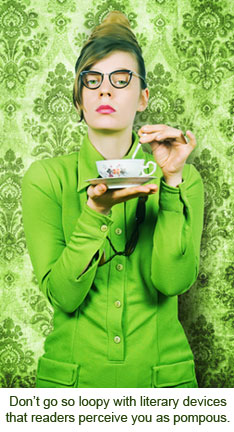by Gila Green"I want to make a paradigm shift in time for that offline chat," says Ilene.
“Sizzle! Think: accountability targeting, transparency concerns, high impact." Savana puts a finger to her temple and then aims it at Ilene. “Pow! We’re fatal to the competition.”
What?
Writers need to be weary of overusing diction (
paradigm shift, offline) and onomatopoeia (
sizzle, pow)—or any other literary device. Diction, in the sense of word choice, is an excellent literary technique to master because few stories have no dialogue at all, which means just about every writer must consider word choice for her characters.
What’s wrong with the above example? The writer is trying to write a modern story, so she’s using modern diction presumably to reinforce time, location and character development. But she’s gone too far. We are lost and probably feeling as though we are reading an advertisement. There’s a good chance the reader is not going to read on.
What is the solution to this problem? Recognize that overdoing modern diction and onomatopoeia means your writing is buzzing with buzz words—a big no-no. A good rule of thumb is no more than three buzz words per line and, even in that case, the dialogue must really suite your character.
Why is this such a sin? Because buzz words often make readers feel as though you are trying to impress them with just how current your writing is and once the reader is aware of the writer you are in danger of losing her, not to mention most readers don’t enjoy pompous writers. For this reason literary devices, such as diction and onomatopoeia in particular, can quickly turn into buzz words. (Buzz words should also not be confused with jargon or insider talk, but that’s another article.)
Mastering literary devices aside, some writers simply don’t notice buzz words. Certain buzz words become everyday words and, in turn, part of our everyday writing. The primary purpose of employing literary devices as a group—not individually—is to reinforce your theme and, thereby, deepen your writing. Overusing those same devices often has the opposite effect: shallow, superfluous and ineffective writing.
So by all means, explore literary devices and go way beyond the two I have used as examples here, but don’t go so far that your writing buzzes into oblivion. Talking down to your readers, inadvertently or not, is a surefire way to lose them.
Don’t go so loopy with literary devices that readers perceive you as pompous.
Originally from Ottawa, an excerpt from Gila Green’s new novel “King of the Class” is short-listed for the Summer Literary Seminars Award (2011). Her stories have appeared in tens of literary magazines in the U.S.A., Canada, Australia, Israel, and Hong Kong. Her short story collection, White Zion, is a finalist for the Doris Bakwin Award (Carolina Wren Press, 2008). Her stories have been short listed for WordSmitten's TenTen Fiction Contest (2008); The Walrus Literary Award (2006/7); the Eric Hoffer Best New Writing Award (2008) and the Ha'aretz Short Fiction Award

by Gila Green
All stories have a shape to them. Draw yours. I learned this in journalism school. At that time it was critical that we mastered the differences between writing for print, radio and television (there was no web writing then). We learned this through shapes. The identical story, say about a student demonstration against a tuition hike, had to be written in three different ways, depending upon which medium it was for. Each medium, we were taught, had its own shape and presumably still does.
I now use this method in my own fiction and in my fiction classes and I find it helps many writers improve their work and organize their thoughts.
Back to your story: Is it circular, a parallel line, or two parallel lines? Does the line peak anywhere? Map out your story visually with a plain pen and paper or rainbow colored markers on Bristol board; whatever inspires you the most. Why? You will see your story in an entirely new way. Using a different medium offers a lot of perspective, even on an old story.
Don’t restrict yourself to drawing; you can dance out your story if you are inclined (and I have two-stepped a story more than once in one of my creative writing workshops). The point of this exercise is to transfer your work into another art form. Paint a scene from your story. Put one whole chapter into a poem. Represent your story in another way and this could very well be the key to unlocking the secret of your work.
Now, let’s examine some possible results. If you have drawn a flat line, it’s very likely that your story reads like this: exposition, exposition, exposition. Another flat-line diagnosis: endless dialogue that tries to fit in three generations of family history in a going-nowhere back and forth between two moody characters.
Viola! You now know that you need to either cut exposition and put in dialogue or cut dialogue and throw in some exposition, atmosphere, action; something to break that long flat line!
If your writer’s block is so severe that you have not even begun your story, don’t despair. Draw a published story. But don’t just lean over and grab the closest book. Choose one that makes you see the world through different eyes; one you have read repeatedly and (best option) one that makes you burn with envy. Don’t just read it from the perspective of shape either, really draw it!
Is this story so successful because it opens on such a sharp peak? Is it the way two parallel lines—representing the heroine and her foil, perhaps—are chasing each other like Tom & Jerry that draws (pun intended) you in? Find a satisfying answer before you move back to your own tale.
Remember, art is interconnected. If the traditional “go for a walk to clear your head” advice isn’t working, stroll all the way to the art section for a pack of crayons or a paint brush.
***








One of my habits that I've unfortunately discarded was my tendency to write on unlined paper. Instead of stopping my pencil completely, I would doodle on the side until I found a way to continue!
I like the idea of 'drawing' your plot. Now I'm trying to picture which of my favorite books are flat lines, wavy tangents, or spirals!
I absolutely love this idea applied to writing fiction. I recently read a book on dealing with the loss of a loved one by "mapping" the stages of your grief in a similar manner (drawing). Excellent (and helpful) post!
This is a great post. In the past I have paused and doodled on a pad of paper or something when I was supposed to be writing, but never realized it was a connect to breaking the block. Now I can do this purposefully with your tips and know what the visual and creative are merging to bring out the story. Very cool.
Dear MK:
Thanks for the positive feedback. BTW, "drawing" your plot can also work for "drawing" your characters, atmosphere and any other story elements.
Gila
It's great to hear from Petula and Becca that this post resonates with writers. Feel free to try it and then post results or a question. I'd be happy to respond.